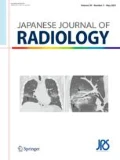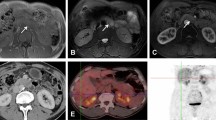Abstract
Purpose
KL-6 is an extracellular epitope of MUC1, a membrane-penetrating glycoprotein, and its overexpression has been reported in pancreatic cancer. The aim of this study was to examine whether radiolabeled anti-KL-6/MUC1 antibody could be used for molecular imaging of pancreatic cancer in vivo.
Materials and methods
Anti-KL-6/MUC1 antibody was labeled with 99mTc by the stannous reduction method. Immunoreactivity of the 99mTc-labeled anti-KL-6/MUC1 antibody was evaluated by a whole-cell binding study. In vivo experiments were performed by injecting the 99mTc-labeled anti-KL-6/MUC1 antibody into athymic nude mice bearing the KP-1NL pancreatic cancer cell line.
Results
A whole-cell binding study showed that the radiolabeled antibody retained its immunoreactivity. On scintigrams, the density of the tumors remained unchanged during the 16–32 h after injection, whereas that of the kidneys decreased time-dependently. The radioactivity levels of the kidneys and tumors were measured densitometrically, and we found that the intensity in the tumors relative to that in the kidneys increased time-dependently. Radioactivity levels were the highest in the blood 32 h after injection, and those in the liver, kidney, lung, and tumor were also rather high.
Conclusion
99mTc-labeled anti-KL-6/MUC1 antibody appears to be a promising agent as a tumor-specific radiotracer for pancreatic cancer.
Similar content being viewed by others
References
Freelove R, Walling AD. Pancreatic cancer: diagnosis and management. Am Fam Physician 2006;73:485–492.
Tezel E, Kaneko T, Sugimoto H, Takeda S, Inoue S, Nagasaka T, et al. Clinical significance of intraportal endovascular ultrasonography for the diagnosis of extrapancreatic nerve plexus invasion by pancreatic carcinoma. Pancreatology 2004;4:76–81.
Smith JR, Oates E. Radionuclide imaging of the thyroid gland: patterns, pearls, and pitfalls. Clin Nucl Med 2004;29:181–193.
Clark AN, Beller GA. The present role of nuclear cardiology in clinical practice. Q J Nucl Med Mol Imaging 2005;49:43–58.
Van Den Bossche B, Van de Wiele C. Receptor imaging in oncology by means of nuclear medicine: current status. J Clin Oncol 2004;22:3593–3607.
Bumgardner GL, Hardie I, Johnson RW, Lin A, Nashan B, Pescovitz MD, et al. Results of 3-year phase III clinical trials with daclizumab prophylaxis for prevention of acute rejection after renal transplantation. Transplantation 2001;72:839–845.
Campbell P, Marcus R. Monoclonal antibody therapy for lymphoma. Blood Rev 2003;17:143–152.
Karube Y, Katsuno K, Takata J, Matsunaga K, Haruno M, Kuroki M, et al. Radioimmunoscintigraphy using technetium-99m-labeled parental mouse and mouse-human chimeric antibodies to carcinoembryonic antigen in athymic nude mice bearing tumors. Nucl Med Biol 1996;23:753–759.
Meenakshi A, Ganesh V, Suresh Kumar R, Siva Kumar N. Radioimmuno targetting 99mtechnetium labeled anti-epidermal growth factor receptor monoclonal antibodies in experimental tumor models. Q J Nucl Med 2003;47:139–144.
Bian HJ, Chen ZN, Deng JL. Direct technetium-99m labeling of anti-hepatoma monoclonal antibody fragment: a radio-immunoconjugate for hepatocellular carcinoma imaging. World J Gastroenterol 2000;6:348–352.
Rusckowski M, Qu T, Chang F, Hnatowich DJ. Technetium-99m labeled epidermal growth factor-tumor imaging in mice. J Pept Res 1997;50:393–401.
Steinstrasser A, Oberhausen E. Anti-CEA labeling kit BW 431/26, results of the European multicenter trial. Nuklearmedizin 1995;34:232–242.
Gold DV, Modrak DE, Ying Z, Cardillo TM, Sharkey RM, Goldenberg DM. New MUC1 serum immunoassay differentiates pancreatic cancer from pancreatitis. J Clin Oncol 2006;24:252–258.
Simms MS, Murray A, Denton G, Scholfield DP, Price MR, Perkins AC, et al. Production and characterization of a C595 antibody-99mTc conjugate for immunoscintigraphy of bladder cancer. Urol Res 2001;29:13–19.
Schuhmacher J, Kaul S, Klivenyi G, Jundermann H, Magener A, Henze M, et al. Immunoscintigraphy with positron emission tomography: gallium-68 chelate imaging of breast cancer pretargeted with bispecific anti-MUC1/anti-Ga chelate antibodies. Cancer Res 2001;61:3712–3717.
Kohno N, Akiyama M, Kyoizumi S, Hakoda M, Kobuke K, Yamakido M. Detection of soluble tumor-associated antigens in sera and effusions using novel monoclonal antibodies, KL-3 and KL-6, against lung adenocarcinoma. Jpn J Clin Oncol 1988;18:203–216.
Stahel RA, Gilks WR, Lehmann HP, Schenker T. Third International Workshop on Lung Tumor and Differentiation Antigens: overview of the results of the central data analysis. Int J Cancer Suppl 1004;8:6–26.
Kohno N, Inoue Y, Hamada H, Fujioka S, Fujino S, Yokoyama A, et al. Difference in sero-diagnostic values among KL-6-associated mucins classified as cluster 9. Int J Cancer Suppl 1994;8:81–83.
Kohno N, Kyoizumi S, Awaya Y, Fukuhara H, Yamakido M, Akiyama M. New serum indicator of interstitial pneumonitis activity: sialylated carbohydrate antigen KL-6. Chest 1989;96:68–73.
Kohno N. Serum marker KL-6/MUC1 for the diagnosis and management of interstitial pneumonitis. J Med Invest 1999;46:151–158.
Hamada H, Kohno N, Hiwada K. A new serum tumor marker, CAM 123-6, highly specific to pulmonary adenocarcinoma. Jpn J Cancer Res 1994;85:211–219.
Hamada H, Kohno N, Yokoyama A, Kondo K, Yang SZ, Hiwada K, et al. A novel monoclonal antibody, H9, directed against the core protein of MUC1 mucin. Oncol Rep 2000;7:225–232.
Balthazar EJ. Pancreatitis associated with pancreatic carcinoma: preoperative diagnosis: role of CT imaging in detection and evaluation. Pancreatology 2005;5:330–344.
Van Gulik TM, Moojen TM, van Geenen R, Rauws EA, Obertop H, Gouma DJ. Differential diagnosis of focal pancreatitis and pancreatic cancer. Ann Oncol 1999;10(suppl 4):85–88.
Farnell MB, Pearson RK, Sarr MG, Dimagno EP, Burgart LJ, Dahl TR, et al. A prospective randomized trial comparing standard pancreatoduodenectomy with pancreatoduodenectomy with extended lymphadenectomy in resectable pancreatic head adenocarcinoma. Surgery 2005;138:618–630.
Pedrazzoli S, Pasquali C, Sperti C. General aspects of surgical treatment of pancreatic cancer. Dig Surg 1999;16:265–275.
Berberat P, Friess H, Kashiwagi M, Beger HG, Büchler MW. Diagnosis and staging of pancreatic cancer by positron emission tomography. World J Surg 1999;23:882–887.
Zimny M. Diagnostic imaging of pancreatic cancer: the role of PET. Front Radiat Ther Oncol 2004;38:67–75.
Higashi T, Saga T, Nakamoto Y, Ishimori T, Fujimoto K, Dol R, et al. Diagnosis of pancreatic cancer using fluorine-18 fluorodeoxyglucose positron emission tomography (FDG PET): usefulness and limitations in “clinical reality.” Ann Nucl Med 2003;17:261–279.
Sendler A, Avril N, Helmberger H, Stolifuss J, Weber W, Bengel F, et al. Preoperative evaluation of pancreatic masses with positron emission tomography using 18F-fluorodeoxyglucose: diagnostic limitations. World J Surg 2000;24:1121–1129.
Nishiyama Y, Yamamoto Y, Yokoe K, Monden T, Sasakawa Y, Tsutsui K, et al. Contribution of whole body FDG-PET to the detection of distant metastasis in pancreatic cancer. Ann Nucl Med 2005;19:491–497.
Pimentel GJ, Vázquez JE, Quesada W, Felipe Y, Carderón C, Freyre FM, et al. Hexa-histidine tag as a novel alternative for one-step direct labeling of a single-chain Fv antibody fragment with 99mTc. Nucl Med Commun 2001;22:1089–1094.
Author information
Authors and Affiliations
Corresponding author
About this article
Cite this article
Matsumura, K., Niki, I., Tian, H. et al. Radioimmunoscintigraphy of pancreatic cancer in tumor-bearing athymic nude mice using 99mtechnetium-labeled anti-KL-6/MUC1 antibody. Radiat Med 26, 133–139 (2008). https://doi.org/10.1007/s11604-007-0207-6
Received:
Accepted:
Published:
Issue Date:
DOI: https://doi.org/10.1007/s11604-007-0207-6




